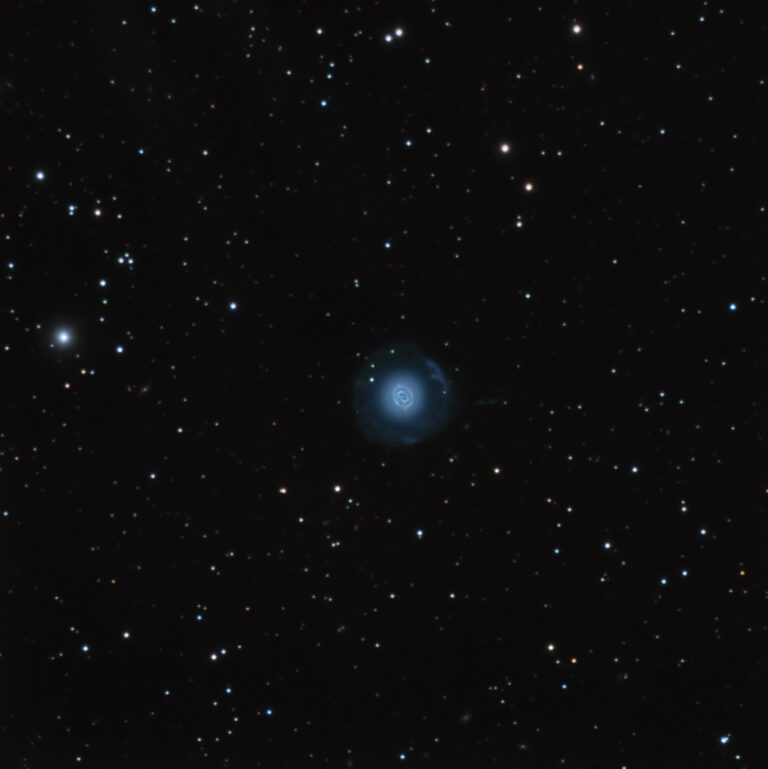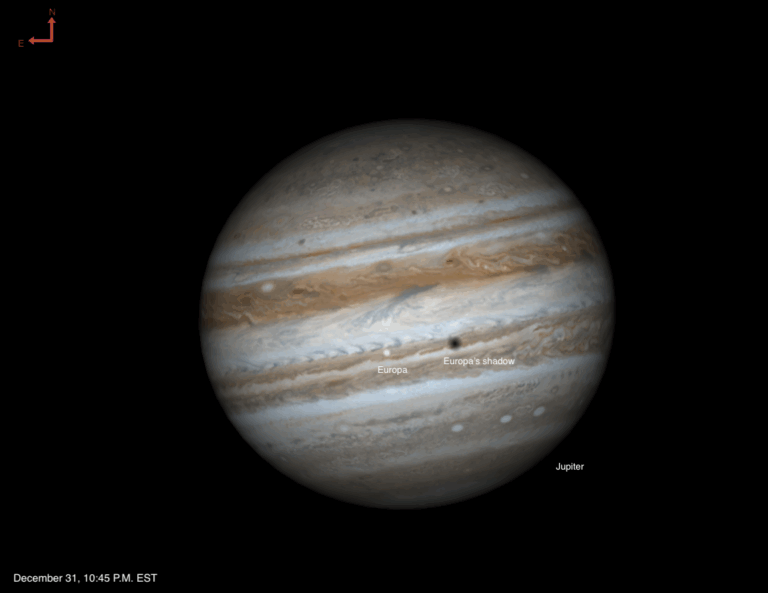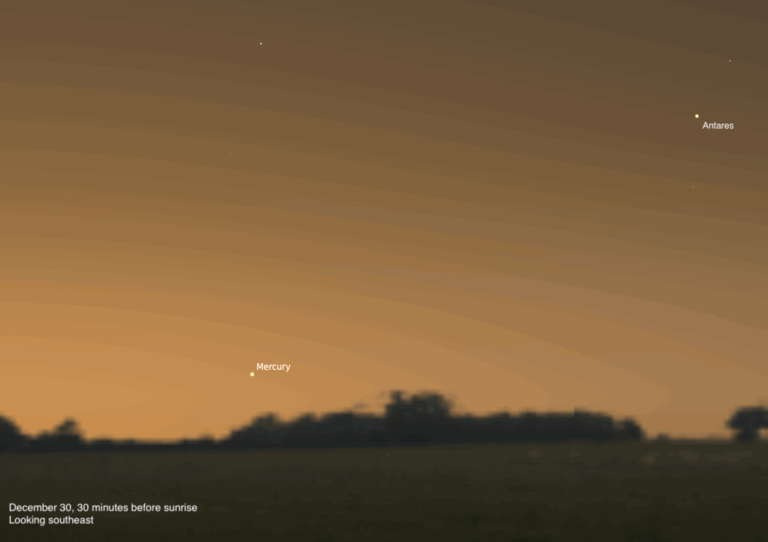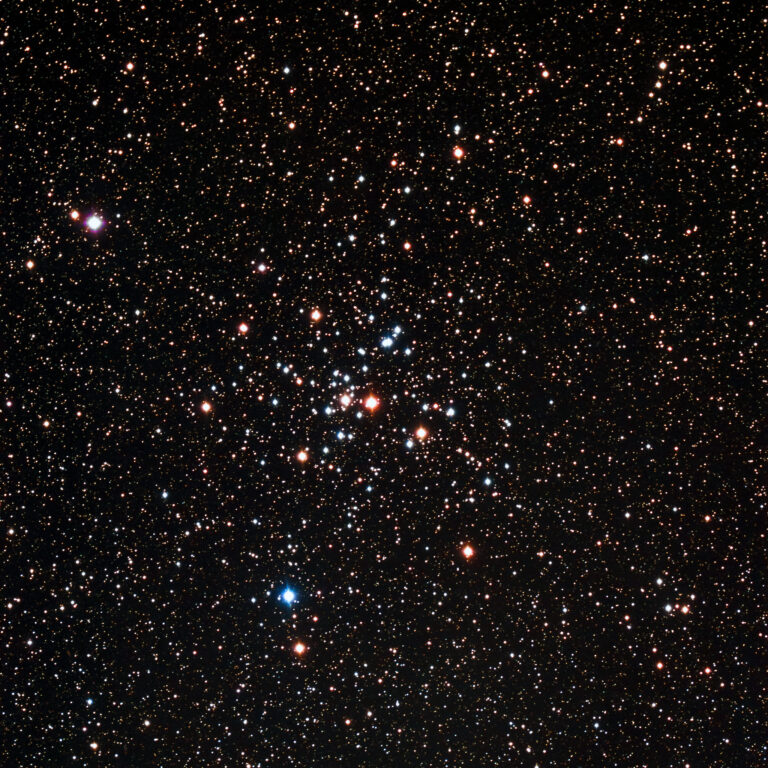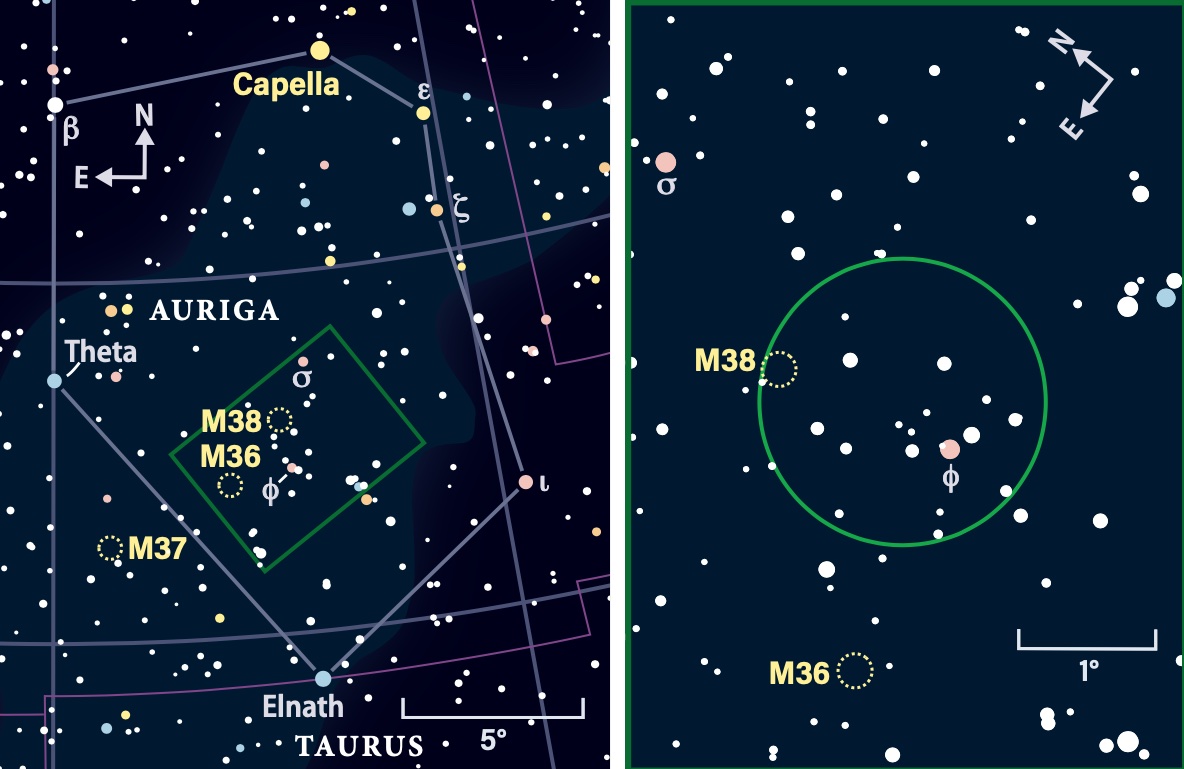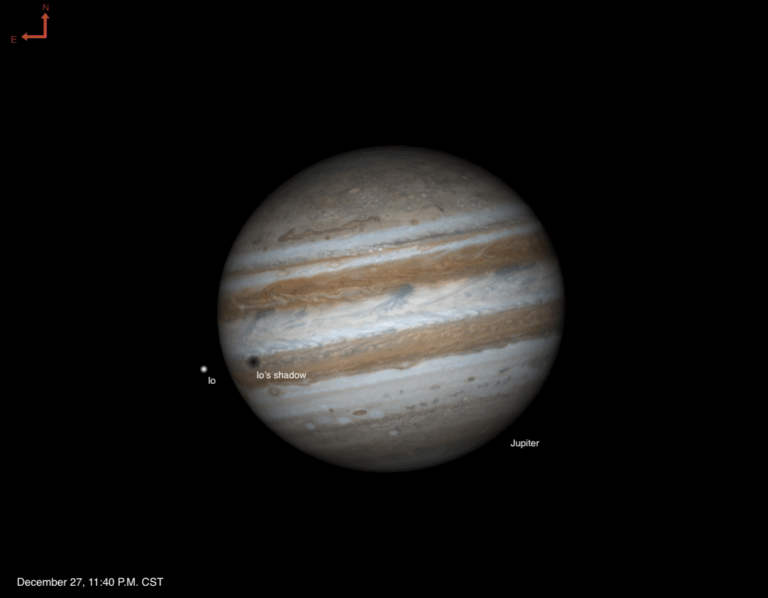
Key Takeaways:
- Planetary observations include Venus passing 1.3° north of Uranus on March 31, Saturn's reappearance in the early morning sky from April 4, and Mercury's visibility in the western sky as it approaches greatest eastern elongation by April 7.
- Deep-sky object targets comprise the globular cluster M3 in Canes Venatici, the open clusters M35 and NGC 2158 in Gemini, and the Orion Nebula (M42) which encompasses the Trapezium Cluster.
- Lunar events include the Moon reaching apogee on March 31, transitioning through waxing gibbous phases, and culminating in a Full Moon (Pink Moon) on April 6, which impacts the visibility of fainter celestial objects.
- Additional observing opportunities feature the dwarf planet 1 Ceres near Denebola in Leo's tail, the variable star Propus (Eta Geminorum), and the optical double star Nu (ν) Boötis, resolvable with optical aid.
Friday, March 31
The Moon reaches apogee, the farthest point from Earth in its orbit, at 7:17 A.M. EDT. It will then sit 251,605 miles (404,919 kilometers) away.
A few hours earlier, Venus passes 1.3° north of Uranus at 2 A.M. EDT. The two planets are visible in the evening, still less than 2° apart. Around sunset, you’ll easily spot magnitude –4 Venus some 30° high in the west. Let the sky darken just a little, then pull out binoculars or a telescope and look to the planet’s south (lower left) for magnitude 5.9 Uranus. Its dim, tiny disk will pop out more readily as darkness falls.
Closer to the horizon, Mercury (10° high 20 minutes after sunset) and Jupiter (3° high 20 minutes after sunset) are still visible, if briefly. Meanwhile, ruddy Mars still flies high in the sky, up above the V-shaped constellation Taurus.
Once the sky has darkened and you’ve had a chance to enjoy the planetary parade, turn your attention to the finest globular cluster the spring sky has to offer: M3. Located in Canes Venatici, you’ll find it about halfway between the Hunting Dogs’ alpha star, Cor Caroli, and Arcturus (Alpha [α] Boötis) in the Herdsman. At magnitude 6.2, the cluster may be just at the edge of naked-eye vision from a dark site, though tonight’s bright Moon may dash your chances of spotting it. That’s okay — binoculars or a telescope will easily reveal the dense ball of stars. The former will show it as a fuzzy patch of light, while the latter should start to resolve myriad suns around its edges, with more appearing the larger your aperture.
Containing tens of thousands of stars, M3 spans nearly 20′ on the sky, with a dense center just over 1′ wide. The cluster is rising after sunset and highest overnight.
Sunrise: 6:46 A.M.
Sunset: 7:23 P.M.
Moonrise: 1:59 P.M.
Moonset: 4:29 A.M.
Moon Phase: Waxing gibbous (74%)
*Times for sunrise, sunset, moonrise, and moonset are given in local time from 40° N 90° W. The Moon’s illumination is given at 12 P.M. local time from the same location.
Saturday, April 1
Mars lies directly above (northeast of) open cluster M35 in Gemini this evening. About an hour after sunset, you’ll find the Red Planet roughly 60° high in the west and shining at magnitude 0.9. It lies near one foot of Gemini the Twins, about 3° due north of Propus (Eta [η] Geminorum).
Mars now appears about 6″ across, so discerning surface features is difficult unless you’re experienced with high-speed video capture. While you may not get much from the Red Planet, drop about 1.8° down (southwest) to find M35, a 5th-magnitude open cluster spanning roughly the size of the Full Moon. Although this target is technically visible with the naked eye, the Moon’s pervading light will again likely render it invisible without some optical aid. But because this is a bright open cluster, any magnification should offer a glittering view — and in fact, lower power and a wider field of view are desirable here. If you are using higher power, look for NGC 2158, a fainter (magnitude 8.6), more compact open cluster just ¼° southwest of M35.
Finally, slide back to Propus: This is a well-known variable star whose brightness changes by some 50 percent over the course of roughly two-thirds of a year. Compare it with nearby Mu (μ) Geminorum to its east — Mu is a steady magnitude 2.9, while Propus swings between magnitudes 3.3 and 3.9. So, at its dimmest, Propus is a full magnitude fainter than Mu, while at its brightest, the two are much closer in appearance.
Sunrise: 6:44 A.M.
Sunset: 7:24 P.M.
Moonrise: 3:02 P.M.
Moonset: 5:01 A.M.
Moon Phase: Waxing gibbous (82%)
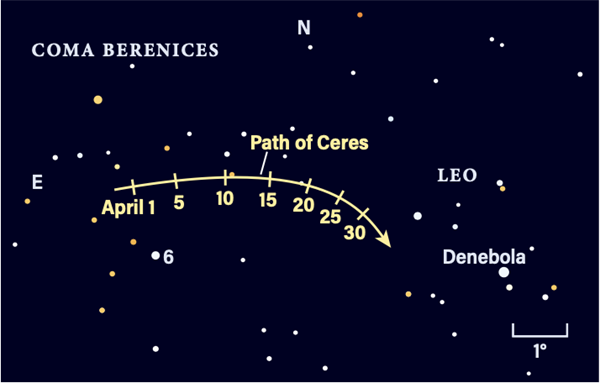
Sunday, April 2
Seventh-magnitude 1 Ceres is an easy-to-find object near the tip of Leo’s tail all month. The waxing Moon is close by this evening, but Ceres should is still achievable in a telescopic field of view.
Start by locating magnitude 2.1 Denebola, roughly 35° high in the east an hour after sunset and climbing quickly. It lies east of the Moon. From this star, skim 6.5° farther east to 5th-magnitude 6 Comae Berenices. Ceres sits less than 1.5° north of this star, making its way slowly west over the first half of the month, then swinging slightly south toward Denebola. The dwarf planet will likely stand out against the sparse background, which contains few faint stars.
If you want to chart its movement, you’ll need to do so over the course of several nights. Take an image or make a quick sketch tonight, then come back day after day — or better yet, give it a few days as the brightening Moon passes through. When you return, use the chart above to identify Ceres and see how it’s moved.
Sunrise: 6:42 A.M.
Sunset: 7:25 P.M.
Moonrise: 4:04 P.M.
Moonset: 5:27 A.M.
Moon Phase: Waxing gibbous (88%)
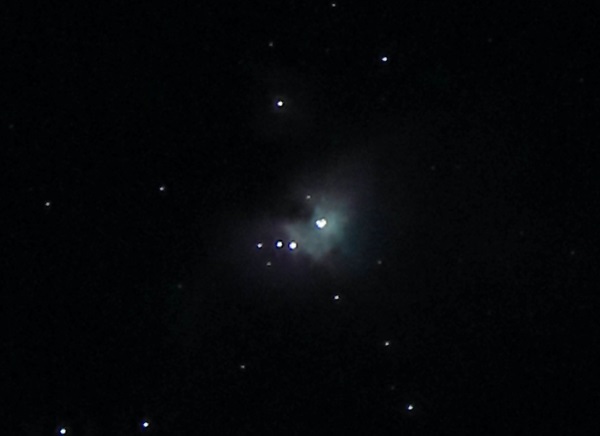
Monday, April 3
With the Moon dominating the eastern sky, let’s look west after sunset for an oldie but a goodie: M42, popularly known as the Orion Nebula. This showstopper lies in Orion the Hunter, forming the sword that hangs below his easternmost Belt star, Alnitak.
Stretching at least 1° on each side, the 4th-magnitude nebula is generally easy to see with the naked eye on a dark night. With the Moon interfering, we’ll need binoculars or a telescope to bring out its delicate glow. M42 is a nearby star-forming region where numerous young stars shine brightly, lighting up the gas around them. Darker dust threads throughout, blocking light and lending to its unique appearance.
Within the bright central regions of M42 is Theta1 (θ) Orionis, a multiple-star system that comprises the Trapezium Cluster. Astronomy columnist Stephen James O’Meara recently challenged skywatchers to see whether they could split Theta1 and Theta2 Orionis with the naked eye, an effort you can take up tonight. In fact, a bright Moon may help this effort, as it diminishes the visible glow of the nebula around them. Regardless of your success, any telescope will readily show the Trapezium nestled among the nebula’s dust and gas.
Sunrise: 6:41 A.M.
Sunset: 7:26 P.M.
Moonrise: 5:06 P.M.
Moonset: 5:51 A.M.
Moon Phase: Waxing gibbous (94%)
Tuesday, April 4
The ringed planet Saturn is reappearing in the sky. Let’s switch to early-morning observing today, as the gas giant rises around 5 A.M. local time and is 10° above the eastern horizon 30 minutes before sunrise. It will appear as a faint star in the brightening sky and is best enjoyed with a telescope, which will show off its 16″-wide disk and stunning rings. The rings stretch just over twice the width of the planet itself.
Those rings have been slowly growing narrower and are now inclined just 9° to our line of sight. They will continue to thin throughout the summer, so now is the best time to catch them.
Saturn’s largest and brightest moon, Titan, lies far to the planet’s east this morning. It sits some 2′ due east of the center of the planet’s disk. At magnitude 8.9, it will be difficult to spot in the growing twilight, but if you’ve got a decent-sized scope, consider giving it a try. Don’t worry if you’re not having much luck, though — Titan will be easier to spot later in the month, so we’ll surely return to it. Saturn itself will continue to rise several minutes earlier each day, meaning you’ll be able to enjoy it in a darker sky for longer as time passes. It will continue to improve in appearance through the summer as it heads for an August opposition.
Sunrise: 6:39 A.M.
Sunset: 7:27 P.M.
Moonrise: 6:08 P.M.
Moonset: 6:12 A.M.
Moon Phase: Waxing gibbous (98%)
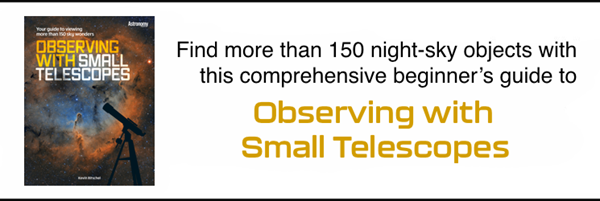
Wednesday, April 5
Whether or not you passed the Theta Orionis challenge earlier this week, we’ve got an easier pair of stars for you to view tonight. Nu (ν) Boötis is considered one of spring’s most striking doubles and can be split with binoculars or a telescope, putting the view within reach of anyone with either of those options at their disposal.
You’ll find Nu in northeastern Boötes. Wait a few hours after dark, by which time the region will have risen quite high in the north. Nu is a 5th-magnitude star located 5.5° due east of Nekkar, the constellation’s magnitude 3.5 beta star. Once you’ve found your target, you’ll discover that it’s made of a golden star to the west (that’s Nu1) and a bluer star to the east (Nu2). They sit about 10′ apart — and that distance gives a hint of their relationship, which is to say they don’t have one at all! These stars are not a true binary but a chance superposition of two suns at disparate distances. They actually sit at least 400 light-years apart in space.
Consider also swinging your gaze over to Arcturus (Alpha Boötis), an unmissable orangey-red giant star that glows at magnitude –0.1 in the southern part of the Herdsman. This elderly star is much brighter but also cooler than our own Sun, hence its color.
Sunrise: 6:38 A.M.
Sunset: 7:29 P.M.
Moonrise: 7:11 P.M.
Moonset: 6:33 A.M.
Moon Phase: Full
Thursday, April 6
Full Moon occurs just after midnight at 12:35 A.M. EDT. The April Full Moon is also called the Pink Moon. According to Farmers’ Almanac, the name comes from the flowers that bloom in early spring, including the moss pink (also called creeping phlox) prevalent in the eastern U.S.
A Full Moon makes the entire sky bright and remains above the horizon from roughly sunset to sunrise, affecting our view of the heavens. It’s also unfortunately not the ideal time to study our satellite, either, as the Sun is shining down directly on the lunar surface, washing out shadows and diminishing detail.
The Moon sits in Virgo this evening, floating some 5° east of the bright star Spica. To its north, you may spot Arcturus, which we viewed last night. And Regulus, which marks the heart of Leo the Lion, lies northwest of the Moon’s position. You may also be able to make out the Big Dipper in the north, standing on the end of its handle for most of the night. Other visible bright stars earlier in the evening include Capella in Auriga, Aldebaran in Taurus, Betelgeuse and Rigel in Orion, and the ruler of them all, Sirius the Dog Star in Canis Major.
Sunrise: 6:36 A.M.
Sunset: 7:30 P.M.
Moonrise: 8:16 P.M.
Moonset: 6:55 A.M.
Moon Phase: Full
Friday, April 7
You may have noticed a bright spot quickly climbing day by day in the western sky just after sunset. Mercury is making its way toward its greatest eastern elongation from the Sun on the 11th and remains visible for about an hour and a half after sunset tonight. The small planet has been fading in brightness as it slides away from the Sun and is now magnitude –0.5, about half a magnitude fainter than at the start of the month.
The smallest planet in the solar system, Mercury’s disk stretches just 7″ across. It appears slightly larger than Mars up in Taurus because it currently sits closer to Earth than the Red Planet, which affects their relative angular sizes. Mercury is located in Aries the Ram, roughly even above the horizon with the constellation’s magnitude 2.6 beta star Sheratan 6.7° to its right (northwest). Above Sheratan in the sky (northeast) is Aries’ brightest star, 2nd-magnitude Hamal.
Sunrise: 6:35 A.M.
Sunset: 7:31 P.M.
Moonrise: 9:24 P.M.
Moonset: 7:18 A.M.
Moon Phase: Waning gibbous (98%)



